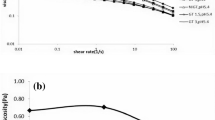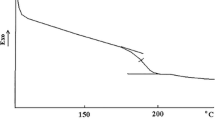Abstract
Recently, special behavior of interfacial tension during and after microwave irradiation was found. To understand the behavior in more details, microwave irradiation pattern was changed in this study. Higher power and longer irradiation time, which do not cause the boiling at the interface, are better for the reduction of interfacial tension and irradiation retention. Accordingly, the quick thermal response of microwave is essential for modification of interface compared to the conventional heating. In this way, interfacial tension does not return quickly to the original value, and effect of the reduction slowly disappeared for a few weeks.










Similar content being viewed by others
References
Rajak VK, Singh I, Kumar A, Mandal A (2016) Optimization of separation of oil from oil-in-water emulsion by demulsification using different demulsifiers. Pet Sci Technol 34:1026–1032. https://doi.org/10.1080/10916466.2016.1181654
Ali M, Alqam M (2000) The role of asphaltenes, resins and other solids in the stabilization of water in oil emulsions and its effects on oil production in Saudi oil fields. Fuel 79:1309–1316. https://doi.org/10.1016/S0016-2361(99)00268-9
Czarnecki J (2009) Stabilization of water in crude oil emulsions. Part 2. Energy Fuel 23:1253–1257. https://doi.org/10.1021/ef800607u
Sullivan AP, Kilpatrick PK (2002) The effects of inorganic solid particles on water and crude oil emulsion stability. Ind Eng Chem Res 41:3389–3404. https://doi.org/10.1021/ie010927n
Moradi M, Alvarado V, Huzurbazar S (2011) Effect of salinity on water-in-crude oil emulsion: evaluation through drop-size distribution proxy. Energy Fuel 25:260–268. https://doi.org/10.1021/ef101236h
Poindexter MK, Chuai S, Marble RA, Marsh SC (2005) Solid content dominates emulsion stability predictions. Energy Fuel 19:1346–1352. https://doi.org/10.1021/ef049797w
Xia L, Lu S, Cao G (2004) Stability and demulsification of emulsions stabilized by asphaltenes or resins. J Colloid Interface Sci 271:504–506. https://doi.org/10.1016/J.JCIS.2003.11.027
Da Silva EB, Santos D, De Brito MP et al (2014) Microwave demulsification of heavy crude oil emulsions: analysis of acid species recovered in the aqueous phase. Fuel 128:141–147. https://doi.org/10.1016/j.fuel.2014.02.076
Chagnes A, Pospiech B (2013) A brief review on hydrometallurgical technologies for recycling spent lithium-ion batteries. J Chem Technol Biotechnol 88:1191–1199. https://doi.org/10.1002/jctb.4053
Antes FG, Diehl LO, Pereira JSF et al (2017) Effect of ultrasonic frequency on separation of water from heavy crude oil emulsion using ultrasonic baths. Ultrason Sonochem 35:541–546. https://doi.org/10.1016/J.ULTSONCH.2016.03.031
Gupta RK, Dunderdale GJ, England MW, Hozumi A (2017) Oil/water separation techniques: a review of recent progresses and future directions. J Mater Chem A 5:16025–16058. https://doi.org/10.1039/C7TA02070H
Holtze C, Sivaramakrishnan R, Antonietti M et al (2006) The microwave absorption of emulsions containing aqueous micro- and nanodroplets: a means to optimize microwave heating. J Colloid Interface Sci 302:651–657. https://doi.org/10.1016/J.JCIS.2006.07.020
Binner ER, Robinson JP, Silvester SA et al (2014) Investigation into the mechanisms by which microwave heating enhances separation of water-in-oil emulsions. Fuel 116. https://doi.org/10.1016/j.fuel.2013.08.042
Martínez-Palou R, Cerón-Camacho R, Chávez B et al (2013) Demulsification of heavy crude oil-in-water emulsions: a comparative study between microwave and thermal heating. Fuel 113. https://doi.org/10.1016/j.fuel.2013.05.094
Santos D, da Rocha ECL, Santos RLM et al (2017) Demulsification of water-in-crude oil emulsions using single mode and multimode microwave irradiation. Sep Purif Technol 189:347–356. https://doi.org/10.1016/j.seppur.2017.08.028
Stone HA, Stroock AD, Ajdari A (2004) Engineering flows in small devices. Annu Rev Fluid Mech 36:381–411. https://doi.org/10.1146/annurev.fluid.36.050802.122124
Abdurahman NH, Yunus RM, Azhari NH et al (2017) The potential of microwave heating in separating water-in-oil (w/o) emulsions. Energy Procedia 138:1023–1028. https://doi.org/10.1016/J.EGYPRO.2017.10.123
Antonow GN (1907) Sur la tension superficielle à la limite de deux couches. J Chim Phys 5:372–385. https://doi.org/10.1051/jcp/1907050372
Cini R, Loglio G, Ficalbi A (1972) Temperature dependence of the surface tension of water by the equilibrium ring method. J Colloid Interface Sci 41:287–297. https://doi.org/10.1016/0021-9797(72)90113-0
Ataev GM (2007) Anomalous temperature dependence of interfacial tension in water-hydrocarbon mixtures. Russ J Phys Chem A 81:2094–2095. https://doi.org/10.1134/S003602440712031X
Hyde A, Horiguchi M, Minamishima N et al (2017) Effects of microwave irradiation on the decane-water interface in the presence of triton X-100. Colloids Surf A Physicochem Eng Asp 524:178–184. https://doi.org/10.1016/j.colsurfa.2017.04.044
Shibata Y, Hyde A, Asakuma Y, Phan C (2018) Thermal response of a non-ionic surfactant layer at the water/oil interface during microwave heating. Colloids Surf A Physicochem Eng Asp 556:127–133. https://doi.org/10.1016/J.COLSURFA.2018.08.010
Hyde A, Phan C, Ingram G (2014) Determining liquid–liquid interfacial tension from a submerged meniscus. Colloids Surf A Physicochem Eng Asp 459:267–273. https://doi.org/10.1016/j.colsurfa.2014.07.016
Author information
Authors and Affiliations
Corresponding author
Additional information
Publisher’s note
Springer Nature remains neutral with regard to jurisdictional claims in published maps and institutional affiliations.
Rights and permissions
About this article
Cite this article
Sonobe, S., Shibata, Y., Minamishima, N. et al. Interfacial tension behavior between decane-water with triton X-100 under various microwave irradiation conditions. Heat Mass Transfer 56, 1343–1351 (2020). https://doi.org/10.1007/s00231-019-02778-9
Received:
Accepted:
Published:
Issue Date:
DOI: https://doi.org/10.1007/s00231-019-02778-9




